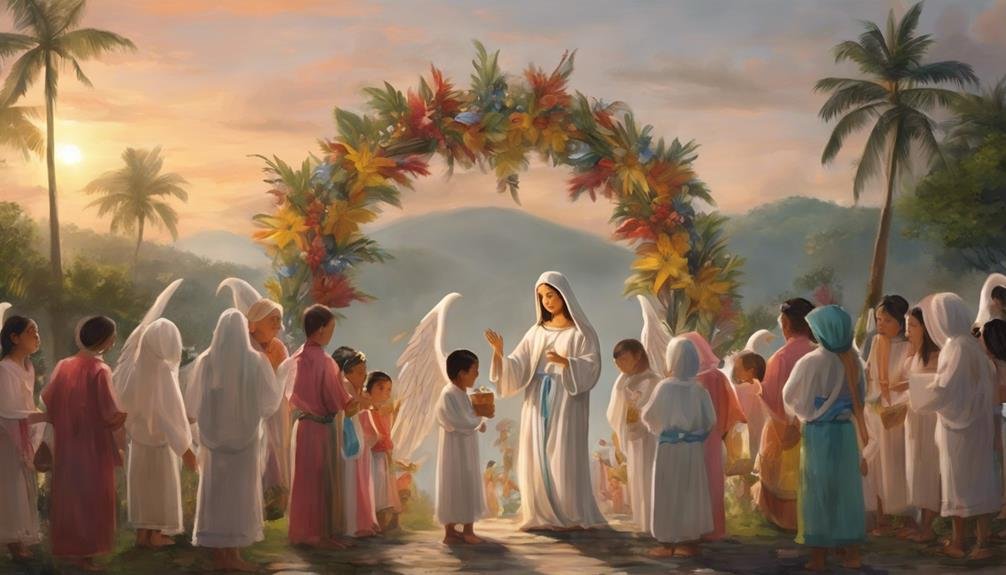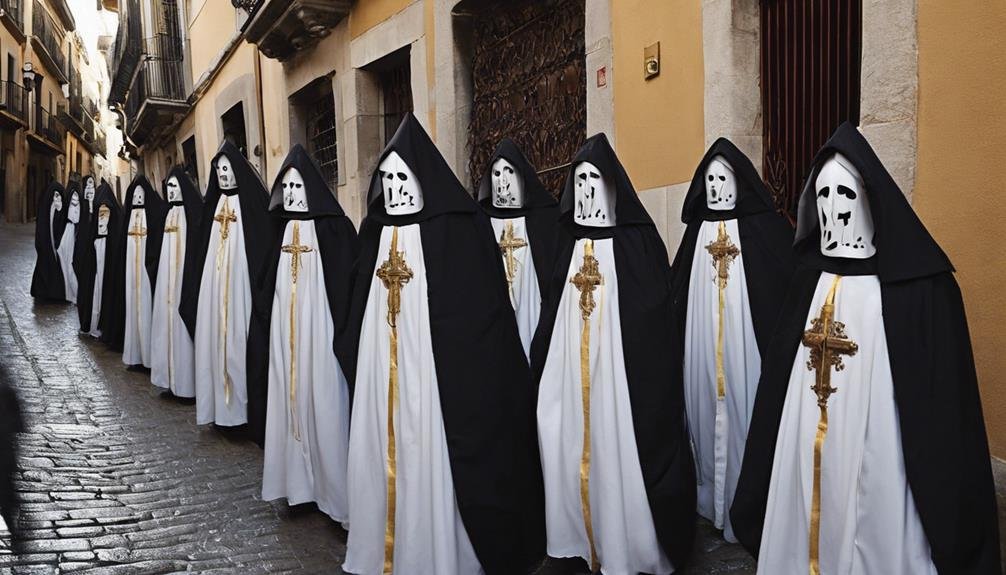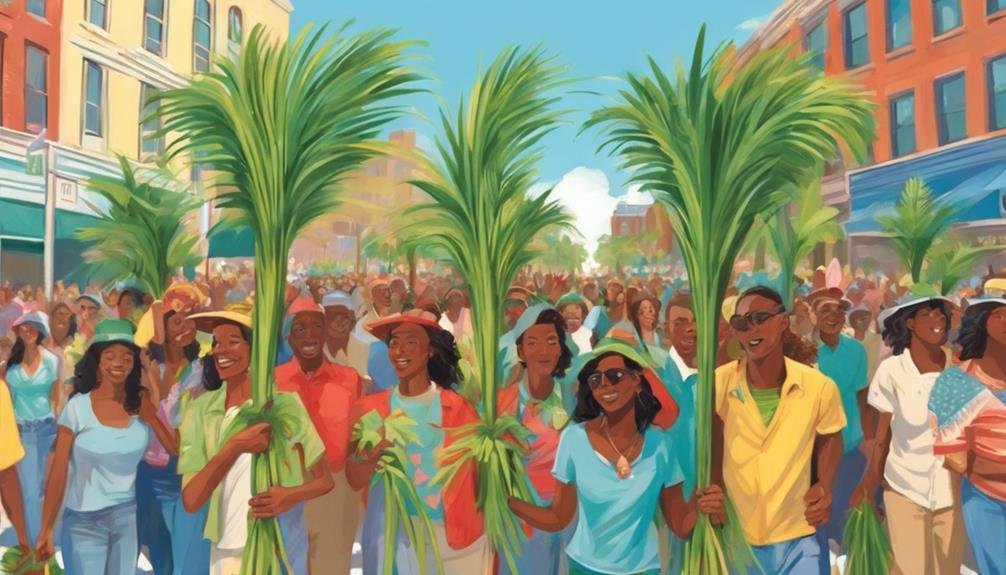As you explore Palm Sunday traditions around the globe, you’ll discover a fascinating blend of rituals that reflect this day’s profound spiritual significance and diverse cultural expressions.
Picture yourself weaving through the bustling streets of a Latin American city, surrounded by vibrant parades, or standing amidst the solemn procession in Spain. Each event is steeped in centuries-old traditions.
From the use of willow branches in Eastern Europe to the intricate palm designs in the Philippines, these practices aren’t just about observance—they’re about community, faith, and the heralding of a significant spiritual season. What might you find surprising about these global celebrations?
Key Takeaways
- In the Philippines, the Salubong ritual features festive processions, singing, and dancing to celebrate Palm Sunday.
- Italian Palm Sunday traditions often involve using olive branches to symbolize peace and prosperity.
- Spain commemorates this day with solemn Holy Week processions showcasing religious figures and artifacts.
- Latin American countries mark Palm Sunday with colorful parades, music, and artistically woven palm fronds.
- In Eastern Europe, willow branches are used instead of palms, symbolizing resurrection and new beginnings.
Origins of Palm Sunday
Palm Sunday traces its roots back to the biblical event where Jesus Christ triumphantly entered Jerusalem, greeted by crowds wielding palm branches as symbols of victory. This significant day marks not just a moment of joy, but also the beginning of a solemn week leading up to Easter.
When you immerse yourself in the origins of Palm Sunday, you’re looking at a celebration that has been observed for centuries. The early church adopted this practice to reenact Jesus’ triumphant entry into Jerusalem.
Imagine the scene: crowds spreading their cloaks on the road, waving palm branches, a gesture reserved for triumphant leaders and kings. This set the stage for the final days of Jesus’ ministry.
This event isn’t just a historical reenactment; it’s a vibrant part of the Christian faith that involves processions and gatherings, bringing the community together in reflection and celebration. As you explore this tradition, you’re connecting with a practice that has united believers in worship and reverence through countless generations.
Symbols and Their Meanings
Exploring the symbols of Palm Sunday reveals layers of spiritual significance, each embodying deep religious beliefs and practices.
Often depicted in the Palm Sunday story, the donkey isn’t just a humble creature; it symbolizes humility and peaceful redemption in Judaism and reflects Christ’s patience and ability to bear burdens in Christianity.
This dual significance enriches your understanding of the day’s profound spiritual underpinnings. These aren’t mere foliage but represent victory and triumph, echoing the biblical narrative’s celebration and reverence.
It’s fascinating how some churches preserve these palms, burning them to create ashes for Ash Wednesday. The red eggs symbolize Christ’s blood, and the bunny, with its connotations of rebirth and fertility, mirrors the resurrection story, emphasizing renewal.
Philippines: Salubong Ritual

The Salubong ritual vividly commemorates the joyous meeting between the Risen Christ and the Blessed Mother in the Philippines. On Palm Sunday, you’d witness a unique cultural blend where deep religious devotion meets vibrant local traditions.
This involves two processions, each carrying statues — one of the Risen Christ and one of the Blessed Mother. These processions symbolically converge at the church, marking a poignant moment of reunion celebrated with singing, dancing, and the offering of flowers.
This table provides a quick snapshot of what makes the Salubong ritual a standout event:
| Aspect | Detail | Significance |
|---|---|---|
| Processions | Statues of Christ and the Blessed Mother | Symbolizes the reunion |
| Activities | Singing, dancing, flower offerings | Expresses joy and devotion |
| Cultural Blend | Catholic faith intertwined with Filipino customs | Showcases unique cultural identity |
| Emotional Impact | Joyous, celebratory | Reflects the happiness of resurrection |
| Key Figures | Risen Christ, Blessed Mother | Focus on significant religious icons |
The Salubong ritual isn’t just a religious observance; it’s a heartfelt expression of faith and culture. It echoes the joy of Easter and the reverence for Mary, making it a profound component of Palm Sunday celebrations in the Philippines.
Italy: Olive Branches Tradition
Olive branches, symbolizing peace and prosperity, are poignantly substituted for palms in Italy’s Palm Sunday traditions. While palms are traditional in many regions, Italy embraces the olive branch, deeply rooted in its cultural and historical landscape.
This choice connects directly with biblical symbolism and Jesus’ message as he entered Jerusalem. Here are some engaging aspects of this tradition:
- Cultural Significance: Olive trees are quintessential to Italian landscapes, making their branches a natural symbol of national identity.
- Symbolic Meaning: These branches represent peace, reflecting the peaceful nature of Jesus’ arrival.
- Eco-Friendly Option: Olive branches offer a sustainable alternative to palm branches, aligning with environmental considerations.
- Community Involvement: Families often participate in gathering these branches, fostering a sense of community and shared tradition.
This tradition honors religious history and promotes a message of peace and sustainability, resonating deeply within the Italian community during Palm Sunday celebrations.
Spain: Holy Week Processions

During Holy Week, Spain transforms as the Semana Santa processions fill the streets with solemnity and devotion. Participants march through the cities in traditional robes and hoods, symbols of penitence and anonymity.
This spectacle, deeply rooted in religious traditions, coincides with Palm Sunday and continues throughout the week. Elaborate floats adorned with religious figures are a centerpiece of these processions. Here’s a snapshot of where you can experience some of the most famous processions:
| City | Notable Feature |
|---|---|
| Seville | Renowned for its large and elaborate processions |
| Malaga | Features nighttime processions and vibrant displays |
| Valladolid | Known for its lifelike religious sculptures |
| Zaragoza | Unique for its historical reenactments |
| Granada | Offers processions with stunning backdrops |
Latin America: Colorful Celebrations
Witness the vibrant celebrations of Palm Sunday across Latin America, where communities come alive with colorful processions and traditional music.
It’s a cultural experience that connects the past with the present, blending religious solemnity with communal joy. Here are some key highlights of Palm Sunday in Latin America:
- Intricate Palmas: Artisans create elaborate designs using palm fronds carried in processions or placed in homes for blessings.
- Elaborate Parades: In Mexico, you’ll witness some of the most spectacular parades featuring floats, costumes, and live performances depicting biblical scenes.
- Community Meals: After the day’s events, families and friends gather to share meals, strengthening community bonds.
This blend of tradition, faith, and community makes Palm Sunday a memorable experience in Latin America.
United States: Palm Parades

While Latin America bursts with colorful processions, Palm Sunday in the United States also brings its own unique fervor through widespread palm parades.
You’ll find these parades in numerous churches across the nation, where congregants proudly wave palm branches as they walk.
This blessing transforms the palms into symbols of victory and peace, infusing the Palm Sunday parade with deeper spiritual significance. It’s a moment when the community comes together, united in celebration and reflection. It’s a reenactment and a lively, communal affirmation of faith.
Eastern Europe: Willow Branches
In Eastern Europe, people traditionally use willow branches instead of palms to celebrate Palm Sunday. This unique tradition is steeped in deep cultural and religious significance, reflecting the region’s rich heritage and spiritual landscape.
As you explore why willow branches are so integral to this celebration, you’ll uncover layers of history and meaning. Here are some fascinating aspects of this tradition:
- Symbolism: Willow branches symbolize resurrection and new life, aligning perfectly with the themes of Palm Sunday.
- Historical Roots: The choice of willow branches dates back to ancient pagan customs, which were seamlessly woven into Christian practices.
- Blessing Ceremony: The branches are blessed by clergy, a ritual that imbues them with spiritual significance.
Reflections and Renewal

Moving from the specific traditions of Eastern Europe, let’s now explore how Palm Sunday serves as a time for reflection and renewal in the broader Christian community.
The palms you hold symbolize more than victory; they remind you of renewal. As these palms are transformed into ashes for the next Ash Wednesday, consider how you can transform challenges into victories in the coming year. It’s a perfect time to renew your faith and commitment.
Here’s a glance at what Palm Sunday represents:
| Symbol | Significance |
|---|---|
| Palm Branches | Triumph and victory in your spiritual journey |
| Ashes from Palms | Renewal and preparation for a new beginning |
| Entry into Jerusalem | Reflect on the paths you take and the entrances you make in life |
This Palm Sunday, take a moment to contemplate where you’ve been and where you’re headed. It’s a day for renewal, both spiritually and personally.
Conclusion
As you’ve explored, Palm Sunday isn’t just a day; it’s a vibrant tapestry of traditions that spans the globe. From the solemn processions in Spain to the lively celebrations in Latin America, each custom enriches the spiritual journey of believers.
Whether waving an olive branch in Italy or joining a palm parade in the U.S., you’re part of a worldwide community reflecting, renewing, and growing together. Embrace these rituals and find your path to renewal this Palm Sunday.
Explore More Articles:
Do Jews Celebrate Easter? Insights into Jewish and Christian Holidays
Why Celebrate Palm Sunday With These Family Activities?
Palm Sunday: 3 Key Biblical Events Unveiled

